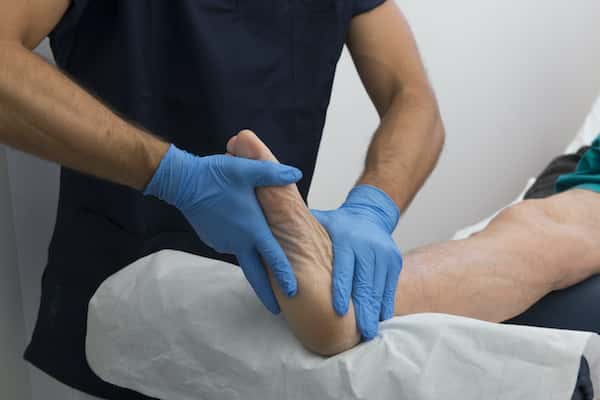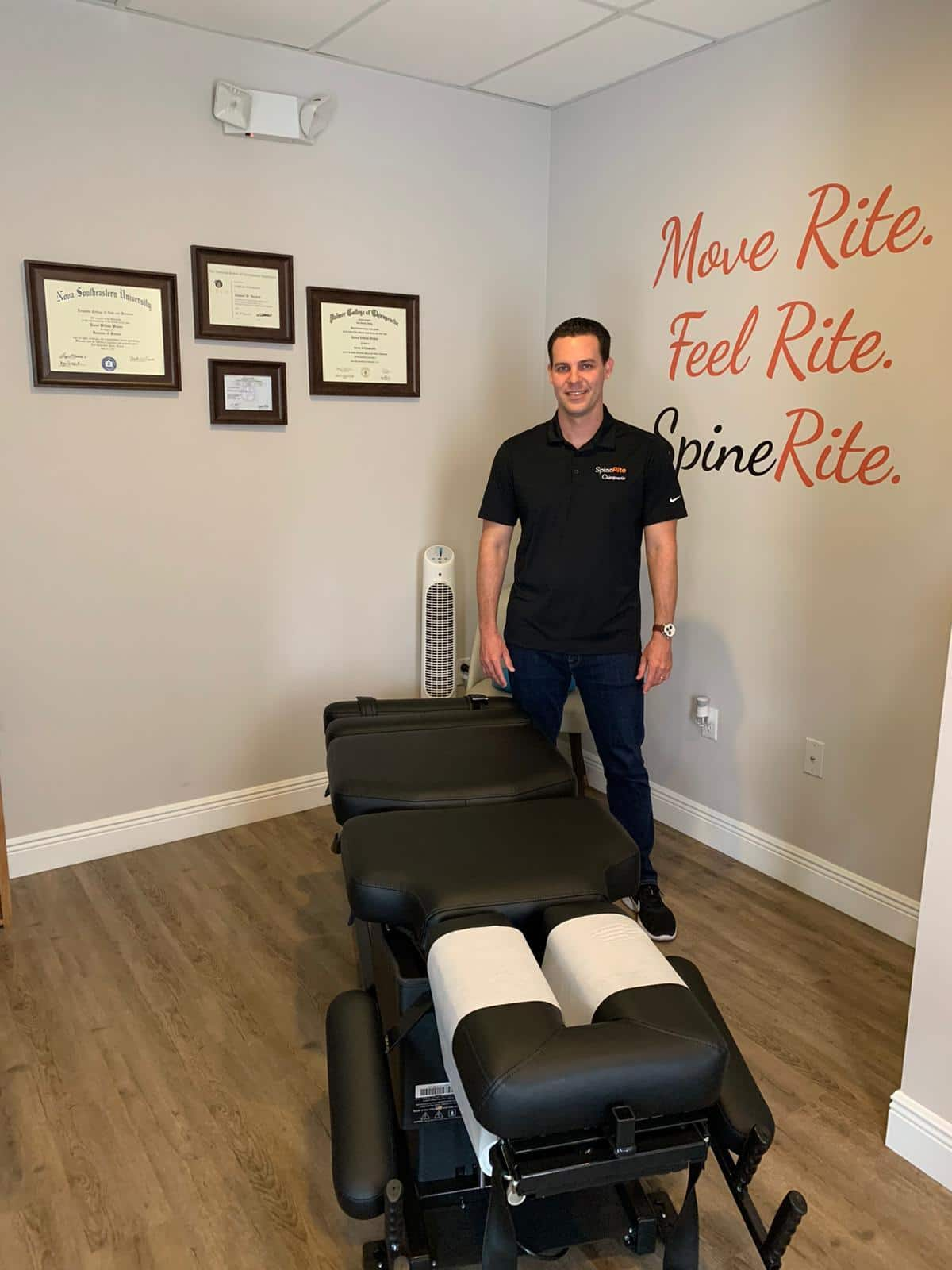SpineRite
Chiropractic
Don't let the pain get over your BODY
Let your body get over the PAIN
SCHEDULE YOUR APPOINTMENT

SpineRite
Chiropractic

Suffering from back pain, neck pain, hip pain, headaches or
car accident injuries?
Chiropractic Healthcare You Deserve








Literally means, Doing by hand. Chiropractic is an alternative form of healthcare that treats symptoms such as back pain, neck pain, headaches, hip pain, radiating pain, numbness as well as many other symptoms through treatment referred to as an spa Adjustment.
One of the most important systems in the body is the nervous system. It allows the brain to communicate with the rest of the body and controls all movement as well as identification of temperature change, as well as pain and pleasure sensations. It originates from the brain and spinal cord which is located within the skull and spine. This is important to know because your spine consists of 24 vertebrae that allow the body's range of motion to take place.
Your vertebrae will have tendencies to get “stuck” and not move properly, creating areas of tension in the body, reducing your range of motion resulting in dysfunction of the body's nervous system based on the vertebra that is “stuck.” As the aging process occurs, as well as, stress, lack of good posture, traumatic injuries, and/or wear and tear from daily use of your body, the vertebrae will have tendencies to get “stuck.”
An adjustment from a Chiropractor will improve the body's range of motion and allow the vertebrae of the spine the move properly and allow the nervous system to function the way it is supposed to. Chiropractic is the safest and most sought-after alternative form of medicine due to its effectiveness and nonopioid approach to whole body wellness, pain relief and management. We look forward to helping YOU and YOUR body move and function at its BEST.

Dr. Daniel Weston of SpineRite Chiropractic offers affordable and exeptional chiropractic care correcting the underlying issues. We believe that the body can heal itself when the spine is properly aligned. SpineRite Chiropractic is a pain relief and wellness center helping you to live your best life through chiropractic adjustments, stretching, and muscle release therapy.
We help the body do just that by realigning the spine. When you choose us for your Chiropractic care, you will receive a personalized treatment plan. The first visit includes a thorough medical history screening, examination and review of any necessary images including X-Rays and/or MRIs. With each adjustment visit we include 8 minutes of problem-focused stretching.
We believe that stretching is essential to alleviate muscle tension and therefore allow the spine to MoveRite and FeelRite. Whether you are suffering from back pain, neck pain, headaches, hip pain, muscle tension/stiffness, shooting/radiating pain, numbness, etc... we have a solution for you. Most pain in the body is generated from the nervous system which is primarily located within the spine. A quality chiropractic adjustment to the spine can provide instant pain relief and increase your body's range of motion.

Prepay and Save

Being able to think clearly and calmly allows us to make decisions, process emotions, and carry on with our day-to-day lives. That clarity can be easily destroyed with a strong headache. Many people have occasional headaches, but frequent headaches that affect your ability to sleep or get on with your day can be disabling.
Headaches have many causes, or “triggers.” These may include foods, environmental stimuli (noises, lights, stress, etc.) and/or behaviors (insomnia, excessive exercise, blood sugar changes, etc.). About 5 percent of all headaches are warning signals caused by physical problems. The remaining 95 percent of headaches are primary headaches, such as tension, migraine, or cluster headaches. These types of headaches are not caused by disease; the headache itself is the primary concern.
Research shows that spinal manipulation — one of the primary treatments provided by doctors of chiropractic — may be an effective treatment option for tension headaches and headaches that originate in the neck. A 2014 report in the Journal of Manipulative and Physiological Therapeutics (JMPT) found that interventions commonly used in chiropractic care improved outcomes for the treatment of acute and chronic neck pain and increased benefit was shown in several instances where a multimodal approach to neck pain had been used1. Also, a 2011 JMPT study found that chiropractic care, including spinal manipulation, improves migraine and cervicogenic headaches.
Our neck, also called the cervical spine, begins at the base of the skull and contains seven small vertebrae. Incredibly, the cervical spine supports the full weight of your head, which is on average about 12 pounds. While the cervical spine can move your head in nearly every direction, this flexibility makes the neck very susceptible to pain and injury.
The neck's susceptibility to injury is due in part to biomechanics. Activities and events that affect cervical biomechanics include extended sitting, repetitive movement, accidents, falls and blows to the body or head, normal aging, and everyday wear and tear. Neck pain can be very bothersome, and it can have a variety of causes.
Here are some of the most typical causes of neck pain:
A neck adjustment (also known as cervical manipulation) is a precise procedure applied to the joints of the neck, usually by hand. A neck adjustment works to improve the mobility of the spine and to restore range of motion; it can also increase movement of the adjoining muscles. Patients typically notice an improved ability to turn and tilt the head, and a reduction of pain, soreness, and stiffness.
A review of scientific literature found evidence that patients with chronic neck pain enrolled in clinical trials reported significant improvement following chiropractic spinal manipulation. As part of the literature review, published in the March/April 2007 issue of the Journal of Manipulative and Physiological Therapeutics, the researchers reviewed nine previously published trials and found “high-quality evidence” that patients with chronic neck pain showed significant pain-level improvements following spinal manipulation. No trial group was reported as having remained unchanged, and all groups showed positive changes up to 12 weeks post-treatment.
The back is a complicated structure of bones, joints, ligaments and muscles. You can sprain ligaments, strain muscles, rupture disks, and irritate joints, all of which can lead to back pain. While sports injuries or accidents can cause back pain, sometimes the simplest of movements for example, picking up a pencil from the floor can have painful results. In addition, arthritis, poor posture, obesity, and psychological stress can cause or complicate back pain. Back pain can also directly result from disease of the internal organs, such as kidney stones, kidney infections, blood clots, or bone loss.
Back pain is a fact of life for many people. Research shows that up to 80% of the population will experience back pain at some point during their lives. It is also the second most common reason for visits to the doctor's office, outnumbered only by upper-respiratory infections. Sometimes back pain is sharp and intense, caused by a wrong move or an injury, and heals in a few days or weeks. Others experience back pain as a chronic condition, seriously altering their ability to work and enjoy time with family, friends and other leisure activities—leading to depression in some cases. A recent global survey of health conditions identified back pain as the single most disabling condition worldwide.
Moreover, as lifestyles have become more sedentary and the rate of obesity has risen, back pain has become increasingly prevalent, even among young children.
Chiropractors deliver a gentle, non-invasive, non-addictive therapy, known as a chiropractic adjustment. Chiropractic adjustments reduce joint restrictions or misalignments in the spine and other joints in the body in an effort to reduce inflammation and improve function of both the affected joint and nervous system. By increasing joint mobility and improving your nervous system function and spinal health, your body has the ability to better manage symptoms caused by low back pain.
Below are some of the health benefits chiropractic care and chiropractic adjustments can provide patients with low back pain:
Spinal health is an important factor in preventing back pain, as well as maintaining overall health and well—being. The American Chiropractic Association (ACA) encourages people to take steps to improve their spinal health and avoid injury. Things such as better nutrition, exercise, ergonomic workspaces and proper lifting and movement techniques can go a long way in helping people to strengthen their spines and potentially avoid serious injury and chronic pain. When back pain hits, research shows that a conservative approach to treatment is the best option.
If you are experiencing a shooting, piercing pain that runs from the lower back down to the legs, you are probably suffering from sciatica pain. Sciatic is the longest nerve in the body running from the buttocks right down to the toes. The nerve can experience pain whenever you have a trapped nerve, disc herniation, Piriformis syndrome, or trigger point referral. Typically, symptoms of sciatica include the following:
While sciatica pain can be severe, the majority of the time the condition is resolved in a matter of weeks without surgical intervention. Some doctors may suggest surgery if the patient experiences extreme weakness in the leg or has problems with their bowel or bladder. Most of the time doctors will prescribe medication to treat the pain and relax the muscles that surround the sciatic path in an effort to provide the patient with some relief.
Chiropractic has been shown to be very effective in treating sciatica by helping the body heal itself. It is non—invasive and does not use medications, making it an optimal choice for many patients. There are various treatments that a chiropractor may use or recommend. They may be used alone or in conjunction with other therapies.
Spinal manipulation, or adjustments, is the core of chiropractic treatment. It helps to realign the spine, freeing restricted movement and helps bring the body back into its proper alignment so that it functions better and more effectively. It also helps to reduce the pain that is associated with nerve inflammation, particularly that associated with sciatica.
A chiropractor may incorporate exercises and nutritional recommendations into their treatment for sciatica. This often depends on the patient's individual needs, the severity of the condition, and their lifestyle and habits. A variety of chiropractic techniques may also be used to treat sciatica. Since each patient is different, the chiropractor will talk with the patient to better understand what they do on a day-to-day basis and what may be causing the sciatic pain to occur. From there they will treat the problem from the patient's perspective, seeking the best, most effective approach.
For most people, the shoulder is the most mobile joint in the body. Surrounded by nerves, bursa, tendons, and other tissues that can experience or cause irritation, it's not surprising that shoulder pain affects millions of people in the United States each year. Depending on the cause and specifics of your own shoulder condition, there's a good chance chiropractic care can help.
Signs That You Need Treatment:
Chiropractic care can be very beneficial for the patient with an injury or pain in the shoulder. It helps to reduce and relieve pain, improve range of motion, increase flexibility, and restore function to the joint. Depending on the type of injury, a variety chiropractic techniques can be used for treatment.
Common Causes of Shoulder Pain:
Chiropractic care is often the care method of choice for shoulder pain because it is minimally invasive and it works. As is often the case, pain in one part of the body can cause pain in other areas. In the case of shoulder pain, the spine and neck may become inflamed. Chiropractic care addresses all areas of the body to relieve pain without drugs and gets the patient on the road to healing quicker.
A growing portion of the population is suffering from chronic hip and back pain. Shifted hips stem from a variety of underlying issues, including sedentary lifestyles causing anterior pelvic shifts, overuse due to sports or labor, arthritis, osteoporosis, pinched nerves, and more.
Hip pain can result from a number of factors. Abnormalities of the soft tissues, joints, bones, nerves and blood vessels of the hip can all result in pain. There may even be some diseases that can cause pain in the hip, such as arthritis, trochanteric bursitis and shingles. Trauma or injury to the hip can cause pain. Hip pain may also be a result of a problem with the spine or back. Any illness or injury that causes inflammation in the hip joint space will cause the space to fill with fluid and stretch the hip capsule lining resulting in pain. Just like any other joint cartilage, the cartilage can wear away or tear and become the source of pain. Plus, hip pain may be due to other structures outside the hip joint. For example, a femoral hernia or inflammation of the sciatic nerve can cause hip pain.
Studies have shown that chiropractic can increase mobility and lessen pain when patients are experiencing hip pain. Treatment can be quite effective for many hip conditions. Since chiropractic steers clear of unnecessary medications and surgery, it is non-invasive and can be used regularly with minimal risk of side effects. Even if the condition you suffer from is not completely eliminated by treatment, it can make your symptoms much more tolerable by reducing pain and improving mobility.
By realigning your spine, adjustments can reduce or eliminate strain that may be placed on your hips. Regular adjustments can help ensure that your body maintains alignment and minimizes the amount of unnecessary strain might be impacting your hip area.
Muscular tension, spasms or “knots” occur when muscles contract involuntary for a sustained period of time. Technically, localized areas of muscle tension are known as myofascial trigger points. These bundles of muscular tension have altered circulation and nervous system activity. Traditionally, scientist believed that these areas endured excessive nerve impulses, causing the over-stimulated muscle in remaining contracted; however, new research suggests that the opposite may hold true. Muscular knots may actually suffer from impaired nerve flow or under-stimulation which inhibits nerve signals telling these muscle fibers to relax.
While acute cases of muscle soreness may result from a recent injury, long-term (chronic) trigger points evolve from inadequate healing of a past injuries, repetitive activities such as desk or computer work, sports, or even emotional stress, lack of sleep and/or dehydration. Muscle tension is also nearly always tied with poor poster and misaligned spine. Specifically, myofascial pain is associated with a common condition called vertebral subluxation, which occurs when spinal bones (vertebrae) are restricted in their movement is in poor alignment.
Muscles fasten to bones via tendons and when spinal bones are out of alignment, they pull connecting muscles out of their proper position, causing imbalance and muscle tension. In addition, spinal bones (vertebrae) stack one on top of another to form the spinal column. Inside this column is a hollow canal through which the spinal cord flows. The spinal cord — along with the brain to which it attaches — makes up the central nervous system. Nerves enter and exit the spinal column through openings between vertebrae and travel to the structures throughout the body.
Chiropractic adjustments are gentle, safe, hands on maneuvers which we use to correct vertebral subluxations in patients' spines. Researchers explain that chiropractic adjustments quell muscle tension by two primary pathways: (1) by restoring the spine to proper alignment and motion and (2) by allowing nerve impulses that prompt muscles to relax.
Many problems can cause radiating pain. Any time there is damage to a part of your body, pain signals may occur. A pinched nerve may occur where there is a large amount of pressure on a nerve, causing pain or tingling to radiate out from the nerve area. Sciatica occurs when there is injury or damage to your sciatic nerve, which runs from your spine through your butt to your legs. Sciatica can cause pain throughout that entire area. Disc herniation can also lead to radiating pain. A herniated disc leads to nerve pressure, causing pain to radiate down your arms or legs depending on the location of the herniation. Spinal stenosis, which is when your spinal cord narrows and puts pressure on your nerves, is another potential cause of radiating pain.
Radiating pain is pain that travels from one part of the body to another. It usually begins in one specific area and spreads to a larger area. It can travel from your back down your legs or into your arms. Radiating pain usually indicates there is a larger problem.
Chiropractic adjustments will reduce your pain, improve your range of motion, and improve your body's natural ability to heal itself. Spinal manipulation works in conjunction with stretching and relaxation.
Numbness and tingling are abnormal sensations that can occur most commonly in the fingers, hands, feet, arms, or legs. The two types of numbness and tingling you can experience are:
The feelings of numbness and tingling can be the result of simply putting undue pressure on an area, which cuts off the blood flow, or it can be the result of an injury to a nerve. For example, a neck injury may cause you to feel numbness anywhere along your arm or hand, while a low back injury can cause numbness or tingling down the back of your leg.
Other causes of numbness and tingling that should be evaluated are:
Misalignments of the spine cause nerve interference that can lead to health problems such as migraines, or they can simply disrupt nerve communication or block proper blood flow. Either way, it is necessary to remove spinal misalignments so that the body can once again function as it should. Chiropractic care focuses on treating the nervous system, including the spinal column. Because nerves are the primary focus of chiropractic care, it is only logical that chiropractic care is a safe and effective method for treating nerve problems that cause numbness and tingling. After a thorough examination for problem areas in the spine, gentle chiropractic adjustments can remove misalignments and restore proper nerve function to reduce the numbing and tingling in the extremities. Not only will you experience proper blood flow, but removing misalignments will also increase function of the body's various systems and promote optimal levels of health and wellness to reduce symptoms of other health conditions.
At SpineRite Chiropractic,
we're dedicated to your well-being.
Reach out to us with any questions or concerns
and someone from our team will get back to you promptly.
Contact us:
9619 W Sample Rd, Coral Springs, Fl, 33065.
Hours of Operation: